|
|
|
Sort Order |
|
|
|
Items / Page
|
|
|
|
|
|
|
| Srl | Item |
| 1 |
ID:
070763


|
|
|
|
|
| Publication |
Santa Monica, Rand Corporation, 1993.
|
| Description |
xxx, 181p.
|
| Standard Number |
0833014188
|
|
|
|
|
|
|
|
|
|
|
|
Copies: C:1/I:0,R:0,Q:0
Circulation
| Accession# | Call# | Current Location | Status | Policy | Location |
| 035118 | 387.73609492/HIL 035118 | Main | On Shelf | General | |
|
|
|
|
| 2 |
ID:
072551
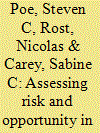

|
|
|
|
|
| Publication |
2006.
|
| Summary/Abstract |
Over the past two decades, substantial progress has been made toward a theoretical understanding of why physical integrity abuses are committed. Unfortunately, these theoretical developments have been devoid of much practical application. In this article, the authors explore the feasibility of risk assessment in the study of these human rights. Borrowing an approach by Gurr and Moore, they construct a risk assessment vehicle that uses existing models and data to develop expectations about future increases and decreases in human rights abuses. Their results indicate that we can isolate a set of cases that are at a higher risk of experiencing increased human rights abuse in the following year, as well as those that are ripe for better protection of human rights. The authors expect these risk and opportunity assessments to be of interest to students of conflict and peace studies, as well as to human rights activists and policy makers.
|
|
|
|
|
|
|
|
|
|
|
|
|
|
|
|
| 3 |
ID:
109140
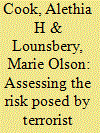

|
|
|
|
|
| Publication |
2011.
|
| Summary/Abstract |
While terrorist organizations have been analyzed for their motivations and tactics, little has been done to develop a systematic understanding of what makes some groups more dangerous than others. Knowing what makes some groups more threatening than others, or what conditions can influence a single group to become more or less of a threat, would help governments to prioritize resources during counterterrorism efforts. Using an approach similar to Ted Robert Gurr's assignment of a risk score to identify impending minority group rebellion, this article develops and tests a set of terrorist organizational characteristics. A two-phased approach is used. First, the authors identify key characteristics that could be anticipated to drive groups to be more active or deadly. The characteristics were identified and measured for terrorist groups for 1990-1994. The authors test group characteristics against subsequent group violence intensity from 1995 to 1999. Findings indicate that some group characteristics, such as religious ideology and group size, are important to understanding a group's relative level of violence. Though the study focused on a relatively short period of time, the findings indicate that a more comprehensive study of the impact that group characteristics have on violence levels would be a worthwhile undertaking.
|
|
|
|
|
|
|
|
|
|
|
|
|
|
|
|
| 4 |
ID:
189654
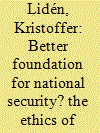

|
|
|
|
|
| Summary/Abstract |
Aiming at analysing all major security risks to a country, comprehensive National Risk Assessments (NRAs) can be used as a foundation for national security policies. Doing so manifests a modernist dream of securing societies through the anticipatory governance of risks. Yet, this dream resembles a nightmare of undemocratic state control in the name of security. Based on a critique of the politics of NRAs, this article offers a theoretical framework for evaluating their scientific and political credentials. Drawing on political theory of technocratic expert rule, ethical criteria of epistemic reliability and political representation are introduced to the debate. These criteria are then applied to an analysis of the NRAs of Sweden, Denmark, Finland, Norway and Iceland. I argue that although these NRAs are convincing correctives to the risk perceptions of politicians and civil society, they are insufficiently reliable and representative for defining the scope and priorities of national security policies at large.
|
|
|
|
|
|
|
|
|
|
|
|
|
|
|
|
| 5 |
ID:
102725
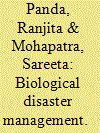

|
|
|
| 6 |
ID:
178323
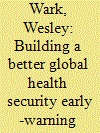

|
|
|
|
|
| Summary/Abstract |
In the years following the Severe Acute Respiratory Syndrome (SARS) outbreak in 2002–2003, the World Health Organization (WHO) created a new system for global disease outbreak surveillance. The system relied on timely reporting by nation-states and gave the WHO a leading role in the global response. It also recognized the value of a multiplicity of sources of information, including from open-source media scanning. The post-SARS system faced its most significant task with the outbreak of the COVID-19 pandemic in the People’s Republic of China and its rapid spread in 2020. The WHO architecture for early warning of disease outbreaks arguably failed and gives rise to questions about how the international community can better respond to pandemic threats in future. This article explores the inter-connectedness of Canada’s system for global health surveillance, featuring the work of the Global Public Health Intelligence Network and that of the WHO, and argues that, while Canada has positioned itself as a global leader, much work needs to be done in Canada, and globally, if the concept of collective health security and shared early warning is to be maintained in the future.
|
|
|
|
|
|
|
|
|
|
|
|
|
|
|
|
| 7 |
ID:
115281
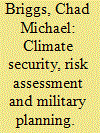

|
|
|
|
|
| Publication |
2012.
|
| Summary/Abstract |
Climate and environmental changes pose emerging and unique challenges to international security-as the global community experiences issues of food insecurity, severe droughts and floods-and have cascading impacts on energy supplies and infrastructure. Environmental hazards may shift abruptly, posing new risks to vulnerable systems and critical nodes in ways that diverge from historical experience. Effective risk assessments and planning will require understanding of how climate change will affect natural disasters and disaster response, and how hazards may be more extreme or unique from past experiences. This article discusses the role of climate change in affecting security planning from a military perspective, and how integration of scientific data and intelligence methods can foster assessment and effective response.
|
|
|
|
|
|
|
|
|
|
|
|
|
|
|
|
| 8 |
ID:
162949
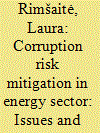

|
|
|
|
|
| Summary/Abstract |
Background of the research is that corruption issues arising in the energy sector strongly depends on the location of the resources as well as the monopolistic nature of the undertakings or political decisions. The participation at the public procurement tenders result the information exchange between the competitors therefore lead to the market closure and increased prices for the end-users. Enforcement of anti-corruption laws have risen, including the imposition of huge fines for the enterprises, and prison sentences for offending corporate executives. The purpose of this article is to analyse and evaluate the factors resulting corruption actions in the energy sector and to reveal the intercourse between the competition law regulation and corruption regulation. The data collection, systemic review and other methods were used. Key findings reveal that corruption occurs due to the specifics of the sector as the resource location, politics, and public procurement. Significance of this research is high due to increased impact of the energy resources to daily life and the monopolistic undertakings resulting high prices to the consumers. Recommendations to minimise the corruption probability highlights the importance of the increased level of transparency and prevention mechanisms especially in the vulnerable areas.
|
|
|
|
|
|
|
|
|
|
|
|
|
|
|
|
| 9 |
ID:
174066
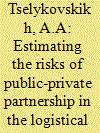

|
|
|
|
|
| Summary/Abstract |
This paper describes a methodology of estimating risks involved in public-private partnership within the framework of furthering the system of logistical support of the RF Armed Forces.
|
|
|
|
|
|
|
|
|
|
|
|
|
|
|
|
| 10 |
ID:
183007
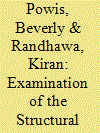

|
|
|
|
|
| Summary/Abstract |
This paper explores the construct validity and structural properties of the ERG22+ formulation tool, used in the assessment of risk and need in extremist offenders. The ERG22+ was developed from a clinical perspective, and was based on the small number of case studies and limited research evidence that were available at the time. It suggests three domains relevant to risk, namely Engagement, Intent, and Capability. These were originally offered as a guide to risk formulation within a functional analysis framework, but were not empirically derived. The items within the ERG22+ are scored on ordinal ratings which offers the possibility to develop subscales within the tool, but the conceptual overlap across the domains offered suggests that these would not be empirically reproduced. In this paper the structural properties of the ERG22+ were examined through factor analysis and multidimensional scaling (MDS) to inform the development of measurement scales. The ERG22+ shows promise as a risk and need formulation tool, which could be developed further in light of the findings from this study. Issues of content validity and areas for further development are discussed.
|
|
|
|
|
|
|
|
|
|
|
|
|
|
|
|
| 11 |
ID:
045999


|
|
|
|
|
| Publication |
New York, Routledge, 2003.
|
| Description |
xxi, 274p.
|
| Standard Number |
0415946425
|
|
|
|
|
|
|
|
|
|
|
|
Copies: C:1/I:0,R:0,Q:0
Circulation
| Accession# | Call# | Current Location | Status | Policy | Location |
| 047008 | 363.32/GEO 047008 | Main | On Shelf | General | |
|
|
|
|
| 12 |
ID:
159143
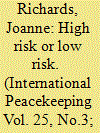

|
|
|
|
|
| Summary/Abstract |
Programmes of disarmament, demobilization, and reintegration (DDR) are increasingly implemented in contexts of violent extremist conflict. In such settings, DDR practitioners may need to distinguish between ex-combatants who can be safely reintegrated into civilian life, and ex-combatants who are likely to present a danger to the community in terms of violent and/or extremist re-offending. To help practitioners make this assessment, this paper explores how risk assessment tools used by psychologists in criminal justice settings may be adapted to screen for violent extremist offenders in DDR programmes. The findings suggest that the method of structured professional judgment (SPJ) can be used to assess the risk that individual ex-combatants will re-offend upon return to civilian life. By extension, SPJ can also: (1) help practitioners to understand what type of deradicalization and disengagement programming former members of extremist groups may require and (2) contribute to decisions concerning the release of ex-combatants from prisons and transitional DDR centres.
|
|
|
|
|
|
|
|
|
|
|
|
|
|
|
|
| 13 |
ID:
171383
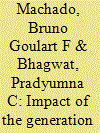

|
|
|
|
|
| Summary/Abstract |
The impact of the generation mix on the two ongoing regulatory frameworks for hydropower remuneration in Brazil is analysed. In the first, Energy Allocation Mechanism (EAM), individual operational risks are mitigated by a risk-sharing principle within a hydro pool structure. The second, Insurance Call Option Obligation (ICO), is an insurance approach which enables the hydro generators to transfer their risks to the consumers. The frameworks are assessed for three long-term scenarios, with a varying share of non-hydro renewables and thermal sources in the generation mix, using a Stochastic Dual Dynamic Programming (SDDP) approach. The results indicate that the generation mix may considerably influence EAM performance and hydropower economic feasibility. An increase in base-load and peak-load thermal generation influences EAM performance negatively, while the penetration of RES does not yield significant impacts if its expansion is met by equivalent increment in load. The ICO approach drives significant transfer of wealth from consumers to generators, which can be addressed by adapting the insurance premium setting criteria, as presented in this study. Finally, ICO design may lead to an overall improvement in the market level welfare, when compared to the EAM, if a criterion of equivalence is set as a preferable design goal.
|
|
|
|
|
|
|
|
|
|
|
|
|
|
|
|
| 14 |
ID:
047032
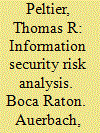

|
|
|
|
|
| Publication |
Boca Raton, Auerbach, 2001.
|
| Description |
xi, 281p.
|
| Standard Number |
0849308801
|
|
|
|
|
|
|
|
|
|
|
|
Copies: C:1/I:0,R:0,Q:0
Circulation
| Accession# | Call# | Current Location | Status | Policy | Location |
| 044489 | 005.8/PEL 044489 | Main | On Shelf | General | |
|
|
|
|
| 15 |
ID:
133261


|
|
|
|
|
| Publication |
2014.
|
| Summary/Abstract |
Grid-connected solar photovoltaic (PV) power is currently one of the fastest growing power-generation technologies in the world. While PV technologies provide the environmental benefit of zero emissions during use, the use of heavy metals in thin-film PV cells raises important health and environmental concerns regarding the end-of-life disposal of PV panels. To date, there is no published quantitative assessment of the potential human health risk due to cadmium leaching from cadmium telluride (CdTe) PV panels disposed in a landfill. Thus, we used a screening-level risk assessment tool to estimate possible human health risk associated with disposal of CdTe panels into landfills. In addition, we conducted a literature review of potential cadmium release from the recycling process in order to contrast the potential health risks from PV panel disposal in landfills to those from PV panel recycling. Based on the results of our literature review, a meaningful risk comparison cannot be performed at this time. Based on the human health risk estimates generated for PV panel disposal, our assessment indicated that landfill disposal of CdTe panels does not pose a human health hazard at current production volumes, although our results pointed to the importance of CdTe PV panel end-of-life management.
|
|
|
|
|
|
|
|
|
|
|
|
|
|
|
|
| 16 |
ID:
132616


|
|
|
|
|
| Publication |
2014.
|
| Summary/Abstract |
Energy lies at the backbone of any advanced society and constitutes an essential prerequisite for economic growth, social order and national defense. However there is an Achilles heel to today×s energy and technology relationship; namely a precarious intimacy between energy and the fiscal, social, and technical systems it supports. Recently, widespread and persistent disruptions in energy systems have highlighted the extent of this dependence and the vulnerability of increasingly optimized systems to changing conditions. Resilience is an emerging concept that offers to reconcile considerations of performance under dynamic environments and across multiple time frames by supplementing traditionally static system performance measures to consider behaviors under changing conditions and complex interactions among physical, information and human domains. This paper identifies metrics useful to implement guidance for energy-related planning, design, investment, and operation. Recommendations are presented using a matrix format to provide a structured and comprehensive framework of metrics relevant to a system×s energy resilience. The study synthesizes previously proposed metrics and emergent resilience literature to provide a multi-dimensional model intended for use by leaders and practitioners as they transform our energy posture from one of stasis and reaction to one that is proactive and which fosters sustainable growth.
|
|
|
|
|
|
|
|
|
|
|
|
|
|
|
|
| 17 |
ID:
153504
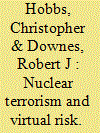

|
|
|
|
|
| Summary/Abstract |
Assessing the risk of nuclear terrorism is a challenging task due to the diversity of actors involved, variety of pathways to success, range of defensive measures employed, and the lack of detailed historical record upon which to base analysis. Numerical models developed to date vary wildly in both approach and ultimate assessment: estimates of the likelihood a nuclear terrorist attack differ by up to nine orders of magnitude. This article critiques existing efforts from the standpoint of probability theory, and proposes an alternative perspective on the utility of risk assessment in this area. Nuclear terrorism is argued to be a ‘virtual risk’ for which it is not possible to meaningfully ascribe a quantitative measure, making numerical estimates of the likelihood of nuclear terrorism misleading. Instead, we argue that focus should be placed on utilising models to identify areas of disagreement as targets for further research, with greater emphasis on understanding terrorist decision-making and adaption in response to nuclear security measures.
|
|
|
|
|
|
|
|
|
|
|
|
|
|
|
|
| 18 |
ID:
109782


|
|
|
|
|
| Publication |
2011.
|
| Summary/Abstract |
Since the mid-1990s, academic and policy communities have debated the risk posed by terrorist use of chemical, biological, radiological, or nuclear (CBRN) weapons. Three major schools of thought in the debate have emerged: the optimists, the pessimists, and the pragmatists. Although these three schools of thought draw on the same limited universe of data on CBRN terrorism, they arrive at strikingly different conclusions. Given the highly subjective process of CBRN terrorism risk assessment, this article analyzes the influence of mental shortcuts (called heuristics) and the systemic errors they create (called biases) on the risk assessment process. This article identifies and provides illustrative examples of a range of heuristics and biases that lead to the underestimation of risks, the overestimation of risks and, most importantly, those that degrade the quality of the debate about the level of risk. While these types of biases are commonly seen as affecting the public's perception of risk, such biases can also be found in risk assessments by experts. The article concludes with recommendations for improving the CBRN risk assessment process.
|
|
|
|
|
|
|
|
|
|
|
|
|
|
|
|
| 19 |
ID:
178926
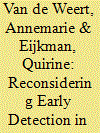

|
|
|
|
|
| Summary/Abstract |
In recent years, the fight against terrorism and political violence has focused more on anticipating the threats that they pose. Therefore, early detection of ideas by local professionals has become an important part of the preventive approach in countering radicalization. Frontline workers who operate in the arteries of society are encouraged to identify processes toward violent behavior at an early stage. To date, however, little is known about how these professionals take on this screening task at their own discretion. Research from the Netherlands suggests that subjective assessment appears to exist. In this article, we argue that the absence of a clear norm for preliminary judgments affects prejudice or administrative arbitrariness, which may cause side effects due to unjustified profiling.
|
|
|
|
|
|
|
|
|
|
|
|
|
|
|
|
| 20 |
ID:
166925


|
|
|
|
|
| Summary/Abstract |
The government needs to consider risk when designing a fiscal regime and oil companies need to assess prospect's risks when facing investment decisions. This paper analyzes how the fiscal regime dictates the risk-reward partition between companies and the government in a portfolio of prospects. The expected monetary value is provided as the decision criteria, and a decision model is presented where all the prospects are graphically represented. The fiscal regime's contract is generalized as a mathematical function and plotted together with the exploratory opportunities. This type of representation helps the policymakers to fine-tune petroleum contracts. It is also of great value to companies because it helps to understand the risks and rewards of a portfolio. We used the recent Brazilian fiscal regime change from a royalty and tax contract (R/T) to a partition share contract (PSC) to understand the impacts of the fiscal regime in the risk-reward balance of the prospects located at the recently discovered Pre-Salt geologic province offshore Brazil. We show how the policymakers can fine-tune the fiscal regime and how companies can better understand the contracts considering both the rewards and the risks involved.
|
|
|
|
|
|
|
|
|
|
|
|
|
|
|
|
|
|
|
|
|